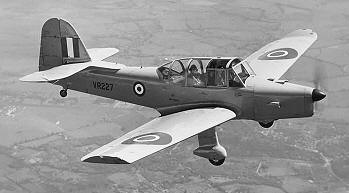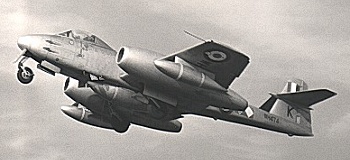 |
Initial Training. First solo and first 100 hours in the lumbering but very safe Percival Prentice. |
|
|
Click on the picture to see more information
 |
Jet conversion, fighter
training and 616 Squadron. Many exciting moments in this rather eccentric and sometimes hazardous aircraft! Initially Gloster Meteor 4, then Meteor 8. See below. |
| 501 Squadron. The De Havilland Vampire handled more like a real fighter (although Israeli Meteors shot down Egyptian Vampires on a couple of occasions). |
 |
| Notes on the Gloster Meteor - the front line fighter of many countries
in the 1950's 1. The first British jet aircraft flew in1941 when Frank Whittle's engine was incorporated into the Gloster E28/39 prototype which was the forerunner of the Gloster Meteor F1. Serious initial problems with stability were only partially fixed with larger tail fin, the Royal Aircraft Establishment itself also being critical of the general handling characteristics. 2. Gloster Meteor F1 the first jet in service with the RAF 1944 - with 616 Squadron. 3. Our first introduction to jets in 1951 at Driffield in Yorkshire surprised us when we saw half the rivets were missing in many of the Meteor 4's. These aircraft had additional stability problems with significant longitudinal shift of centre of gravity caused by use of ammunition and/or fuel. 4. In those days opening or closing the throttle too quickly put the engines out - which of course happened to me while in formation at 30,000 feet. So I had to glide back to the airfield and land with no engines. 5. After a spell immediately after the war with Spitfires, 616 gets Meteors again just before I joined them in 1951. 6. My one crash in my 14 year flying career is in a Meteor 7, landing about half a mile short of the runway and frightening the unfortunate passenger - Christmas 1951. 7. Around 1953 I get locked into a high speed spiral dive in cloud plummeting from 20,000 feet to 10,000 feet and only recovering through absolute maximum corrective force through both hands on the stick and both feet on one rudder. And so I learn from first hand the probable reason why many pilots lost their lives in Meteors flying into the ground at high speed. 8. Finally at Bristol in 1956, in the Meteor 8 which was supposed to have all the stability problems fixed, I found that certain combinations of dive brakes, landing gear lowering and flaps could cause an ostensibly spiral airflow around the aircraft such that it could not turn left. After many peculiar moments trying various manoeuvres trying to get out of the situation, I found that in such a situation it was possible to land only by carrying out a right hand rather than left hand circuit. |